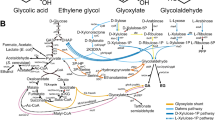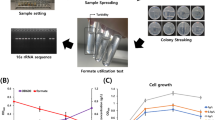Abstract
Objectives
Most butanol-producing strains of Clostridium prefer glucose over xylose, leading to a slower butanol production from lignocellulose hydrolysates. It is therefore beneficial to find and use a strain that can simultaneously use both glucose and xylose.
Results
Clostridium beijerinckii SE-2 strain assimilated glucose and xylose simultaneously and produced ABE (acetone/butanol/ethanol). The classic diauxic growth behavior was not seen. Similar rates of sugar consumption (4.44 mM glucose h−1 and 6.66 mM xylose h−1) were observed suggesting this strain could use either glucose or xylose as the substrate and it has a similar capability to degrade these two sugars. With different initial glucose:xylose ratios, glucose and xylose were consumed simultaneously at rates roughly proportional to their individual concentrations in the medium, leading to complete utilization of both sugars at the same time.
Conclusions
ABE production profiles were similar on different substrates. Transcriptional studies on the effect of glucose and xylose supplementation, however, suggests a clear glucose inhibition on xylose metabolism-related genes is still present.




Similar content being viewed by others
References
Jin L, Zhang H, Chen L, Yang S, Jiang W, Gu Y (2014) Combined overexpression of genes involved in pentose phosphate pathway enables enhanced d-xylose utilization by Clostridium acetobutylicum. J Biotechnol 173:7–9
Joshua CJ, Dahl R, Benke PI, Keasling JD (2011) Absence of diauxie during simultaneous utilization of glucose and xylose by Sulfolobus acidocaldarius. J Bacteriol 193:1293–1301
Kawaguchi H, Vertes AA, Okino S, Inui M, Yukawa H (2006) Engineering of a xylose metabolic pathway in Corynebacterium glutamicum. Appl Environ Microbiol 72:3418–3428
Qureshi N, Blaschek HP (1999) Butanol recovery from model solutions/fermentation broth by pervaporation: evaluation of membrane performance. Biomass Bioenergy 17:175–184
Shen MH, Song H, Li BZ, Yuan YJ (2015) Deletion of d-ribulose-5-phosphate 3-epimerase (RPE1) induces simultaneous utilization of xylose and glucose in xylose-utilizing Saccharomyces cerevisiae. Biotechnol Lett 37:1031–1036
Sun Y, Cheng JY (2002) Hydrolysis of lignocellulosic materials for ethanol production: a review. Bioresour Technol 83:1–11
Wang M, Li Z, Fang X, Wang L, Qu Y (2012) Cellulolytic enzyme production and enzymatic hydrolysis for second-generation bioethanol production. Adv Biochem Eng Biotechnol 128:1–24
Wisselink HW, Toirkens MJ, Wu Q, Pronk JT, van Maris AJA (2009) Novel evolutionary engineering approach for accelerated utilization of glucose, xylose, and arabinose mixtures by engineered Saccharomyces cerevisiae strains. Appl Environ Microbiol 75:907–914
Xiao H, Gu Y, Ning Y, Yang Y, Mitchell WJ, Jiang W, Yang S (2011) Confirmation and elimination of xylose metabolism bottlenecks in glucose phosphoenolpyruvate-dependent phosphotransferase system-deficient Clostridium acetobutylicum for simultaneous utilization of glucose, xylose, and arabinose. Appl Environ Microbiol 77:7886–7895
Yang SL, Liu GJ, Meng YT, Wang P, Zhou SJ, Shang HZ (2014) Utilization of xylose as a carbon source for mixotrophic growth of Scenedesmus obliquus. Bioresour Technol 172:180–185
Acknowledgments
This work was supported by The National Natural Science Foundation of China(No. 31500024), National Key Technology R&D Program of China (No. 2014BAD02B00), Shandong Province Science & Technology Project (No. 2014GSF117005), Shandong Province Natural Science Foundation (No. ZR2012CL04), Jinan Youth Science and Technology Star Project (No. 201406021).
Supporting information
Supplementary Figure 1—16S rDNA phylogenetic tree of S3 strain.
Author information
Authors and Affiliations
Corresponding author
Electronic supplementary material
Below is the link to the electronic supplementary material.
Rights and permissions
About this article
Cite this article
Zhang, J., Zhu, W., Xu, H. et al. Simultaneous glucose and xylose uptake by an acetone/butanol/ethanol producing laboratory Clostridium beijerinckii strain SE-2. Biotechnol Lett 38, 611–617 (2016). https://doi.org/10.1007/s10529-015-2028-5
Received:
Accepted:
Published:
Issue Date:
DOI: https://doi.org/10.1007/s10529-015-2028-5




